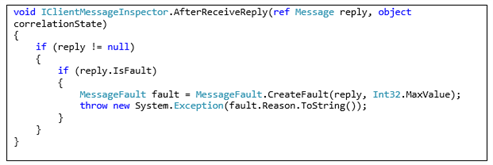At one of our customers I had implemented the ReturnAddress messaging pattern (http://www.enterpriseintegrationpatterns.com/patterns/messaging/ReturnAddress.html), by using a generic BizTalk application which sends an asynchronous response message to a client application. The solution had been running successfully for some time, when we encountered a strange situation.
The BizTalk application uses a one-way WCF-Custom send port, using a wsHttpBinding, to send a message to the client application. Also, I had added the Delivery Notification functionality to make sure messages are delivered successfully.
It is important to realize that one-way send ports that use SOAP will receive a technical response containing an HTTP status code. If and when the send ports receive a HTTP status code in the 200 range, the Delivery Notification generates an ACK and BizTalk knows the message was successfully delivered.
So far, so good. The application had been through testing on the Test and Acceptance environments, had been deployed to the Production environment and had been running for several months without any problems. Until it appeared that some of the messages that were being sent using the generic BizTalk application were ‘not arriving’ at the client application. This would happen at random and, what was really strange, the logging in BizTalk showed that the message was successfully sent and BizTalk had received an ACK response as part of the Delivery Notification. Also there was no mention of an error in the event log of the BizTalk servers.
After some debugging we found the source of the problem. The message sent by BizTalk was successfully received by the client application, however the client application encountered an error processing the message and returned the HTTP 500 status code. So now the question was, why is the Delivery Notification not generating a NACK response when a HTTP 500 status code is received? I had expected that any status code in the HTTP 400 and 500 range would result in a NACK.
This turned out not to be the case. While status codes in the HTTP 400 range will result in a NACK, the status codes in the HTTP 500 range will result in an ACK and BizTalk will view this message as successfully delivered at the client application. The logic behind this seems to be that the status codes in the HTTP 400 range indicate that the message was not received by the client application (hence the NACK) and the status codes in the HTTP 500 range indicate that the message was received by the client application, but that the client application encountered an exception. Since the message was delivered at the client application, BizTalk views this as a successful delivery and will generate an ACK as part of the Delivery Notification.
Unfortunately, there isn’t any documentation on MSDN on which status codes will return an ACK or NACK.
The documentation on the SOAP HTTP response states that “In case of a SOAP error while processing the request, the SOAP HTTP server MUST issue an HTTP 500 “Internal Server Error” response and include a SOAP message in the response containing a SOAP Fault element indicating the SOAP processing error”. For reference, see https://www.w3.org/TR/2000/NOTE-SOAP-20000508/#_Toc478383529.
Some discussion followed on the validity of catching the HTTP 500 error in BizTalk, since the message was successfully delivered and accepted by the client application. That means that, from a technical perspective, the responsibility would now lie at the client application to handle the error. From a functional responsibility perspective however, it was decided to find a way to catch the HTTP 500 error in BizTalk, as this would enable the customer’s administrators to use the same resubmit functionality we had created by using a generic BizTalk error handling framework.
So I had to make sure the HTTP 500 status code was somehow caught, so that BizTalk would return a NACK which would result in the error handling catching the error. Fortunately, this can be achieved quite easily by implementing a WCF behavior on the one-way send port. The WCF behavior checks in the AfterReceiveReply message inspector if the reply is a fault message, and if so it will throw an exception using the fault description.

By implementing this WCF behavior on a one-way send port BizTalk will generate a NACK when a response is received with an HTTP status code in the 400 or 500 range. Sometimes the default behavior surrounding technical responsibility doesn’t align with the requirements and responsibilities from a functional point a view, and this may just offer a solution for you as well.
Subscribe to our RSS feed